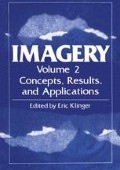Abstract
The hypothesis guiding this presentation is that nonevaluative self-directed attention, especially toward bodily kinesthetic events, may serve as a source of imagery that is perceived to representation-ally fit, intensify, and sometimes change those bodily feelings. The phenomenology of this process, called focusing, has been articulated by Gendlin (1978), who has emphasized its apparent role in psychotherapy (Gendlin, 1977; Gendlin, Beebe, Cassens, Klein, & Oberlander, 1968). Regardless of context, however, focusing is a process of imagery-guided or enhanced (Gendlin & Olson, 1970) change in self-feeling, of the conditions for which we have little concrete understanding. The role of self-directed attention in this process is the object of the present study.
Access this chapter
Tax calculation will be finalised at checkout
Purchases are for personal use only
Preview
Unable to display preview. Download preview PDF.
References Notes
Gendlin, E. T. Imagery is more powerful with focusing: Theory and practice. Paper presented at the American Association for the Study of Mental Imagery Conference, Los Angeles, 1979.
Scheier, M. The effects of public and private self-consciousness on attitude behavior consistency. Unpublished manuscript, Carnagie-Mellon University, 1978.
Wolfe, L., and Vanden Bos, G. Experiential focusing: New research tools. Unpublished manuscript, University of Chicago, 1970.
Platt, A. An experimental evaluation of three methods of focusing training. Unpublished doctoral dissertation, University of Chicago, 1971.
References
Brady, J., and Leavitt, E. Hypnotically induced visual hallucinations. Psychosomatic Medicine, 1966, 28, 351–353.
Buss, A. H. Self-consciousness and social anxiety. San Francisco: Freeman, 1980.
Cooper, L., and Shepard, R. N. Chronometrie studies of the rotation of mental images. In W. Chase (Ed.), Visual information processing. New York: Academic Press, 1973.
Fenigstein, A., Scheier, M., and Buss, A. H. Public and private self-consciousness: Assessment and theory. Journal of Consulting and Clinical Psychology, 1975, 43, 522–527.
Froming, W., and Carver, C. Divergent influences of private and public self-consciousness in a compliance paradigm. Journal of Personality and Social Psychology, in press.
Gendlin, E. T., Beebe, J., Cassens, J., Klein, M., and Oberlander, M. Focusing ability in psychotherapy, personality, and creativity. Research in Psychotherapy, 1968, 3, 217–241.
Gendlin, E. T., and Olson, L. The use of imagery in experimential focusing. Psychotherapy: Theory, Research, and Practice, 1970, 7, 221–223.
Gendlin, E. T. Experiential psychotherapy. In R. J. Corsini (Ed.), Current psychotherapies (2nd ed.). Itasca, Illinois: Peacock, 1977.
Gendlin, E. T. Focusing. New York: Everest House, 1978.
Gibbons, F., Scheier, M., Carver, C., and Hormuth, S. Self-focused attention, suggestibility and the placebo effect. Journal of Experimental Social Psychology, in press.
Hart, J. Memory and the memory monitoring process. Journal of Verbal Learning and Verbal Behavior, 1967, 6, 685–691.
Jacobson, E. Electrical measurements of neuromuscular states during mental activities. IV. Evidence of contraction of specific muscles during imagination. American Journal of Physiology, 1931, 96, 115–121.
Kosslyn, S. M. Information representation in visual images. Cognitive Psychology, 1975, 7, 341–370.
Lang, P. J. A bio-informational theory of emotional imagery. Psychophysiology, 1979, 16, 495–512.
McCarley, R., and Hobson, J. The form of dreams and the biology of sleep. In B. J. Wolman (Ed.), Handbook of dreams: Research, theories, and applications. New York: Van Nostrand, 1979.
Scheier, M., and Carver, C. Self-focused attention and the experiences of emotion: Attraction, repulsion, elation, and depression. Journal of Personality and Social Psychology, 1977, 35, 625–636.
Schwartz, G., Fair, P., Salt, P., Mandel, M., and Klerman, J. Facial muscle patterning to affective imagery in depressed and nonde-pressed subjects. Science, 1976, 192, 489–491.
Segal, S. J., and Fusella, V. Effects of imaging on signal to noise ratio with varying signal conditions. British Journal of Psychology, 1969, 60, 459–464.
Shaw, W. The relation of muscular action potentials to imaginai weight lifting. Archives of Psychology, 1940, 247, 1–50.
Shields, S., and Stern, R. Emotion: The perception of bodily change. In P. Pliner, K. Blankenstein, and I. Speigel (Eds.), Perception of emotion in self and others. New York: Plenum, 1979.
Snyder, M. Self-monitoring of expressive behavior. Journal of Personality and Social Psychology, 1974, 30, 526–537.
Snyder, M., and Monson, T. Persons, situations, and the control of social behavior. Journal of Personality and Social Psychology, 1975, 32, 637–644.
Turner, R., Scheier, M., Carver, C., and Ickes, W. Correlates of self-consciousness. Journal of Personality Assessment, 1978, 42, 285–289.
Turner, R. Consistency, self-consciousness, and the predictive validity of typical and maximal personality predictors. Journal of Research in Personality, 1978, 12, 117–132.
Author information
Authors and Affiliations
Editor information
Editors and Affiliations
Rights and permissions
Copyright information
© 1981 Springer Science+Business Media New York
About this chapter
Cite this chapter
Kuiken, D. (1981). Self-Consciousness as a Component and Correlate of Focusing Ability. In: Klinger, E. (eds) Concepts, Results, and Applications. Springer, Boston, MA. https://doi.org/10.1007/978-1-4684-3974-8_17
Download citation
DOI: https://doi.org/10.1007/978-1-4684-3974-8_17
Publisher Name: Springer, Boston, MA
Print ISBN: 978-1-4684-3976-2
Online ISBN: 978-1-4684-3974-8
eBook Packages: Springer Book Archive

